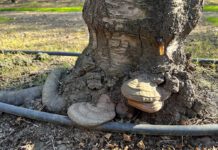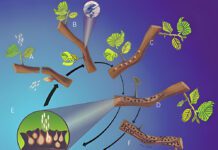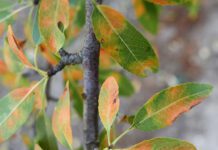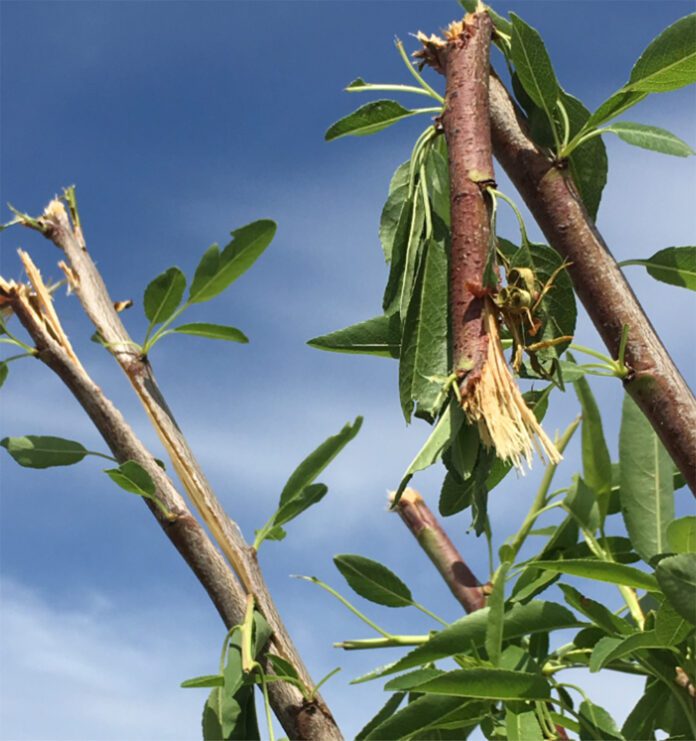
A preventative systems approach to disease management in almond orchards involves cultural practices and management of irrigation and nutrition.
Jim Adaskaveg, plant pathologist at UC Riverside, said although almond orchards can be affected by numerous fungal or bacterial diseases, climatic conditions in California generally limit severe outbreaks of disease, a plus for growers. To further protect orchard health, modification of orchard environment, monitoring for disease and taking note of orchard history can direct management practices.
Disease management begins with noting orchard location, including elevation and proximity to riparian areas. Orchard design, including number of trees per acres, planting design, irrigation system and variety, can also be a factor in disease susceptibility. Age of trees and historical records should also be taken into consideration.
Almond Board of California, along with Semios Precision Agriculture, has developed regionalized disease forecasts that can help with risk prediction. Seven-day disease risk predictions for multiple diseases can be found at industry@almondboard.com.
Springtime Diseases
Occurrence of the springtime diseases brown rot blossom blight, jacket rot, shot hole, anthracnose, bacterial spot and bacterial blast is highly dependent on environmental conditions, specifically rainfall and temperature.
Occurrence of late spring and summer diseases scab, Alternaria leaf spot, rust and hull rot is more dependent on microclimatic orchard conditions and cultural practices.
Adaskaveg said the goal with fungicide programs is to minimize the number of applications and to use the most effective and least costly treatment. Fungicides should be applied when infection risk is highest.
Selecting the best materials with the broadest spectrum and timing the application at a critical stage can lower costs. Adaskaveg said at bloom, a single application with a translaminar fungicide can replace two applications with a contact fungicide under moderately favorable conditions.
He noted generic compounds can lower the cost with four to six timings for the season. Best timings are based on monitoring and environmental conditions.
Cultural practices to minimize diseases in orchards include water and nitrogen management.
Water Management
Wes Asai, former UCCE farm advisor, who operates Wes Asai Pomology Consulting in Turlock, said a simple thing like water management can go a long way in reducing disease outbreaks, rather than using chemical intervention to control disease. Even orchards irrigated with drip or microsprinklers can have issues with standing water if systems are not managed properly.
Young trees, especially potted trees, need water delivery near their roots until their systems become established, but Asai said as the root zone expands, emitters or sprinklers need to be moved away to avoid wetting tree trunks. Internal infections or those caused by contaminated water sources are exacerbated by wetting the trunks.
Cultural practices can also help control freeze event injury and subsequent disease problems with blast. Minimizing cold damage by running sprinklers during freezing weather, even before bloom, can help, Asai said. Controlling weeds in the tree rows allows the bare soil to absorb heat and radiate upward at night, affording some frost protection. Avoid cultivating the middles at peak frost season, Asai advised, because any heat absorbed is not held.
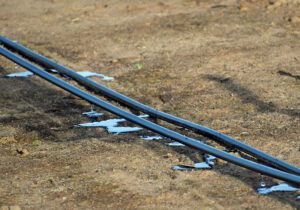
Avoiding pruning when wet weather is forecast and orchard mowing at hull split are also cultural disease prevention strategies. Pruning cuts, particularly large cuts or jagged cuts from hedging and topping, leave wounds that can become infected during wet weather. Most hull rot organisms are soilborne, Asai noted, and mowing orchards at hull split can spread the hull rot pathogens.
Overapplication of nitrogen or incorrect application timing can cause hull rot.
Canker Diseases
UC Plant Pathologist Themis Michailides noted canker diseases can severely impact tree health and productivity if preventative measures are not taken.
Canker is a continuous mass of killed tissues in tree trunks, scaffolds, branches and shoots. The canker pathogen colonizes the entire canker tissues and beyond. Aboveground canker diseases are band canker and ceratocystis canker.
Band canker is a fungal disease in almonds that kills the bark and cambium layer. The pathogens Botryosphaeria dothidea and Hendersonula toruloidea are associated with band canker. The same pathogens can also cause infections in pruning wounds.
Symptoms include amber-colored gum exuding from the canker infection and forming a band around the tree trunk or limb.
Over the last few years, surveys and diagnostics have revealed this disease is prevalent in several major almond-growing counties, including Stanislaus, San Joaquin, Sacramento, Yolo, Solano, Yuba/Sutter, Colusa, Glenn, Butte, Tehama, Madera, Merced, Fresno and even as far south as Kern County.
Band canker presents with single or double bands of gumming around tree trunks. Cankers can result from infections of pruning wound, but Michailides noted distribution of fourth-leaf trees with various levels of cankers led to a hypothesis that trees were delivered to the orchard bearing latent infections but not showing any disease symptoms.
A molecular technique to quantify the DNA of canker pathogens has been developed to detect latent infections. Use of the systemic fungicide Topsin-M, (Thiophanate Methyl) which has preventive and curative action, can also reduce incidence of band canker.
Preventative approaches in young orchards are obtaining disease-free trees from nurseries; spraying trunks of first-, second- and third-leaf orchards with Topsin-M at label rate; and keeping tree trunks dry and protecting pruning wounds with application of Topsin-M at label rate.
When band canker is present in young orchards, keeping tree trunks dry and treating trunks and scaffolds with Topsin-M is advised. Protecting pruning wounds with this material, removing killed trees and stumps and keeping wood piles with their spore inoculum away from the orchard are also preventative measures.
Ceratocystis cankers are caused by a fungus, and infections can begin in trees that have injuries from harvest or other machinery, injuries from the tie rope and insect damage.
To manage this canker, shaker pads should be adjusted to avoid trunk injuries, cut off irrigation within two to three weeks prior to harvest date and limit wounding.
Following correct tree training and scaffold selection along with minimal pruning helps with canker disease management.

Cecilia Parsons | Associate Editor
Cecilia Parsons has lived in the Central Valley community of Ducor since 1976, covering agriculture for numerous agricultural publications over the years. She has found and nurtured many wonderful and helpful contacts in the ag community, including the UCCE advisors, allowing for news coverage that focuses on the basics of food production.
She is always on the search for new ag topics that can help growers and processors in the San Joaquin Valley improve their bottom line.
In her free time, Cecilia rides her horse, Holly in ranch versatility shows and raises registered Shetland sheep which she exhibits at county and state fairs during the summer.







